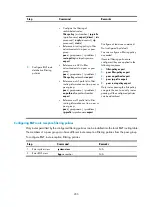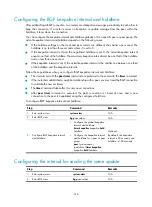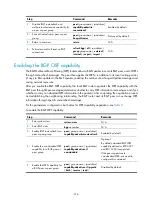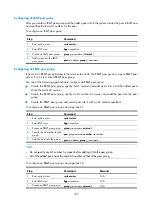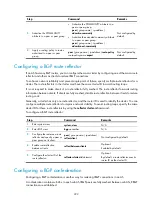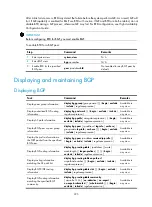
211
Enabling the comparison of MED of routes from confederation peers
The MED attributes of routes from confederation peers are not compared if their AS_PATH attributes
contain AS numbers that do not belong to the confederation, such as these three routes: AS_PATH
attributes of them are 65006 65009, 65007 65009, and 65008 65009; and MED values of them are
2, 3, and 1. Because the third route contains an AS number that does not belong to the confederation,
the first route becomes the optimal route.
To enable the comparison of MED of routes from confederation peers:
Step Command
Remarks
1.
Enter system view.
system-view
N/A
2.
Enter BGP view.
bgp
as-number
N/A
3.
Enable the comparison of MED of
routes from confederation peers.
bestroute med-confederation
Optional.
Not enabled by default.
Configuring the NEXT_HOP attribute
By default, when advertising routes to an IBGP peer or peer group, a BGP router does not set itself as the
next hop. However, to ensure a BGP peer can find the correct next hop in some cases, you must configure
the router as the next hop for routes sent to the peer.
For example, as shown in
, Router A and Router B establish an EBGP neighbor relationship, and
Router B and Router C establish an IBGP neighbor relationship. When Router B advertises a network
learned from Router A to Router C, if Router C has no route to IP address 1.1.1.1/24, you must configure
Router B to set itself as the next hop (3.1.1.1/24) for the route to be sent to Router C.
Figure 87
NEXT_HOP attribute configuration 1
If a BGP router has two peers on a common broadcast network, it does not set itself as the next hop for
routes sent to an EBGP peer by default. As shown in
, Router A and Router B establish an EBGP
neighbor relationship, and Router B and Router C establish an IBGP neighbor relationship. They are on
the same broadcast network 1.1.1.0/24. When Router B sends EBGP routes to Router A, it does not set
itself as the next hop by default. However, you can configure Router B to set it as the next hop (1.1.1.2/24)
for routes sent to Router A by using the
peer next-hop-local
command as needed.
Figure 88
NEXT_HOP attribute configuration 2









